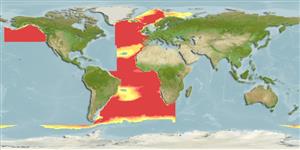Common names from other countries
>
Beryciformes (Sawbellies) >
Melamphaidae (Bigscale fishes or ridgeheads)
Etymology: Poromitra: Greek, poros = porous + Greek, mitra = stripe, belt (Ref. 45335); crassiceps: Named crassiceps for its thick head (Ref. 6885).
More on author: Günther.
Issue
Distribution needs to be defined; previous reports may refer to other species of Poromitra (Ref. 83717, 83719).
Environment: milieu / climate zone / depth range / distribution range
Οικολογία
Θαλασσινό(ά) βαθυπελαγικό(ς); εύρος βάθους 164 - 2730 m (Ref. 83717), usually 750 - 2730 m (Ref. 83717). Deep-water
Distribution needs to be defined. Formerly assigned as senior synonym of eight nominal species: P. atlantica, P. coronata, P. cristiceps, P. frontosa, P. nigriceps, P. nigrofulva, P. rugosa, P. unicornis (Ref. 83717).
Length at first maturity / Μέγεθος / Βάρος / Age
Maturity: Lm 12.3, range 9 - 15.6 cm
Max length : 14.8 cm SL αρσενικό/απροσδιόριστο; (Ref. 54657); μεγ. αναφερόμενη ηλικία: 9 έτη (Ref. 54657)
Short description
Κλείδες προσδιορισμού | Μορφολογία | Μορφομετρία
Ραχιαίες άκανθες (συνολικά) : 3; Μαλακές ραχιαίες ακτίνες (συνολικά) : 12 - 13; Εδρικές άκανθες: 1; Μαλακές εδρικές ακτίνες: 9 - 10; Σπόνδυλοι: 27 - 29. This species is distinguished by the following characters: spinulated (without gap) posterior and lower edges of praeoperculum; insertion of ventral fins behind the vertical of posterior edge of pectoral fin insertion; upper jaw extends beyond the vertical of posterior eye edge; soft rays in dorsal fin 12-13, in anal fin 9-10; rakers at first gill arch 28-30; vertebrae 27-29; pyloric caeca 6 (Ref. 83717).
Oviparous, with planktonic eggs and larvae (Ref. 36655). There is significant morphological variation between populations (Ref. 4241).
Life cycle and mating behavior
Maturities | Αναπαραγωγή | Spawnings | Egg(s) | Fecundities | Προνύμφες
Kotlyar, A.N., 2008. Revision of the genus Poromitra (Melamphaidae): Part 1. Species of group P. crassiceps. J. Ichthyol. 48(7):479-492. (Ref. 83717)
IUCN Red List Status (Ref. 130435)
CITES (Ref. 128078)
Not Evaluated
Threat to humans
Harmless
Human uses
αλιεία: χωρίς ενδιαφέρον
Εργαλεία
Can't connect to MySQL database fbquizv2. Errorcode: Too many connections
